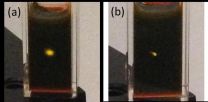(Press-News.org) PITTSBURGH, July 28, 2015 - By studying the yeast used in beer- and bread-making, researchers at the University of Pittsburgh School of Medicine have uncovered the mechanism by which ancient proteins repair DNA damage and how their dysfunction could lead to the development of tumors. The findings, published online today in Nature Communications, could lead to new ways to tailor cancer therapies.
In humans, protein mutations called RAD51 paralogues have been associated with breast and ovarian tumors, said senior investigator Kara Bernstein, Ph.D., assistant professor of microbiology and molecular genetics at Pitt School of Medicine and the University of Pittsburgh Cancer Institute, partner with UPMC CancerCenter.
"These are proteins that have been present throughout evolution in many species, but very little has been known about what they do," she said. "Our study shows for the first time the mechanism of how they are involved in the repair of damaged DNA."
Because RAD51 paralogues are too difficult to work with in animal cells, the research team instead explored their function in yeast. They found the proteins interact with other proteins called the Shu complex to repair breaks in DNA strands, which can be caused by environmental toxins, radiation and other naturally occurring exposures.
Shu complex works synergistically with additional RAD51 paralogues to search for homologous, or complementary, DNA regions with double-strand breaks, in which both poles of the twisting DNA ladder have been broken, the researchers found. Pieces of the genetic code can be lost in such areas; the paralogues and complex repair the damage by filling in the missing pieces in a process called homologous recombination.
"Now that we understand what the proteins do, we can perhaps tailor therapies for patients who have cancer and mutations in these repair genes," Dr. Bernstein said.
INFORMATION:
The team included Stephen K. Godin, Faiz F. Kabbinavar, and Andrew P. Van Demark, Ph.D., of Pitt; and William A. Gaines, Ph.D., Timsi Rao, Ph.D., and Patrick Sung, Ph.D., of Yale University. The project was funded by National Institutes of Health grants ES015252, ES007061, CA168635, GM088413 and GM101808.
About the University of Pittsburgh School of Medicine
As one of the nation's leading academic centers for biomedical research, the University of Pittsburgh School of Medicine integrates advanced technology with basic science across a broad range of disciplines in a continuous quest to harness the power of new knowledge and improve the human condition. Driven mainly by the School of Medicine and its affiliates, Pitt has ranked among the top 10 recipients of funding from the National Institutes of Health since 1998. In rankings recently released by the National Science Foundation, Pitt ranked fifth among all American universities in total federal science and engineering research and development support.
Likewise, the School of Medicine is equally committed to advancing the quality and strength of its medical and graduate education programs, for which it is recognized as an innovative leader, and to training highly skilled, compassionate clinicians and creative scientists well-equipped to engage in world-class research. The School of Medicine is the academic partner of UPMC, which has collaborated with the University to raise the standard of medical excellence in Pittsburgh and to position health care as a driving force behind the region's economy. For more information about the School of Medicine, see http://www.medschool.pitt.edu.
http://www.upmc.com/media
Contact: Anita Srikameswaran
Phone: 412-578-9193
E-mail: SrikamAV@upcm.edu
Contact: Jennifer Yates
Phone: 412-647-9966
E-mail: YatesJC@upcm.edu
DURHAM, N.C. -- The light-sensing molecules that tell plants whether to germinate, when to flower and which direction to grow were inherited millions of years ago from ancient algae, finds a new study from Duke University.
The findings are some of the strongest evidence yet refuting the prevailing idea that the ancestors of early plants got the red light sensors that helped them move from water to land by engulfing light-sensing bacteria, the researchers say.
The results appear online in Nature Communications.
"Much like we see the world through our eyes, plants 'see' ...
OAK BROOK, Ill. - Specific cardiovascular risk factors, such as alcohol consumption, smoking, obesity and diabetes, are associated with smaller regional brain volumes that may be early indicators of Alzheimer's disease and dementia according to a study published online in the journal Radiology.
"We already know that vascular risk factors damage the brain and can result in cognitive impairment," said Kevin S. King, M.D., assistant professor of radiology at the Keck School of Medicine of the University of Southern California in Los Angeles. "But our findings give us a more ...
Adding omega-3 fatty acids to anti-tumor medications may improve treatment response and quality of life for cancer patients according to a new study by researchers at the University Hospitals of Leicester in the United Kingdom.
The study, published today in the OnlineFirst version of the Journal of Parenteral and Enteral Nutrition (JPEN), the research journal of the American Society for Parenteral and Enteral Nutrition (A.S.P.E.N.), examined 50 patients with advanced pancreatic cancer.
Patients were given 1,000 mg of gemcitabine weekly followed by up to 100 g of omega-3 ...
A new study finds that exogenous glucagon-like peptide 2 (GLP-2) treatment may help fight neonatal parenteral nutrition-associated liver disease (PNALD).
The study, published today in the OnlineFirst version of the Journal of Parenteral and Enteral Nutrition (JPEN), the research journal of the American Society for Parenteral and Enteral Nutrition (A.S.P.E.N.), provided neonatal piglets with 17 days of parenteral nutrition therapy and either GLP-2 treatment or saline control. In a previous study, the researchers found that GLP-2 therapy improved bile flow and serum markers ...
Babies born very premature or severely underweight are at heightened risk of becoming introverted, neurotic, and risk averse as adults, indicates research published online in the Archives of Disease in Childhood (Fetal & Neonatal Edition).
This personality profile may help to explain the higher rates of career and relationship difficulties experienced by this group as adults, suggest the researchers.
Very premature birth at less than 32 weeks and/or very low birthweight of less than 1500 g are known to be linked to a heightened risk of autistic spectrum behaviours, ...
Depression and personality disorders are the most common diagnoses among Belgian psychiatric patients requesting help to die, on the grounds of unbearable suffering, finds research published in the online journal BMJ Open.
Drugs, given either by mouth or administered intravenously, are used to perform euthanasia in Belgium, where the practice has been legal since 2002.
The researchers wanted to find out if there were any discernible patterns in requests for euthanasia among mentally ill patients in Belgium in a bid to inform recommendations for future research.
So ...
1. Placebo delivery method affects patient response to "therapy"
Free abstract: http://www.annals.org/article.aspx?doi=10.7326/M15-0623
URLs go live when embargo lifts
A systematic evidence review published in Annals of Internal Medicine finds that the way in which a placebo is delivered makes a difference in how patients respond to "therapy." Having a clinically significant response to the sham treatment could substantially affect outcomes in placebo-controlled trials. The data suggests that some placebos have a stronger effect than others.
Placebo controls, ...
The University of Colorado Cancer Center and Loxo Oncology, Inc. (Nasdaq:LOXO), a biopharmaceutical company focused on the discovery, development and commercialization of targeted cancer therapies, today announced the publication of a research brief in the online edition of the journal Cancer Discovery, describing the first patient with a tropomyosin receptor kinase (TRK) fusion cancer enrolled in the Phase 1 dose escalation trial of LOXO-101, the only selective TRK inhibitor in clinical development. Additional contributors to the paper include the Knight Cancer Institute ...
RIVERSIDE, Calif. -- When it comes to installing solar cells, labor cost and the cost of the land to house them constitute the bulk of the expense. The solar cells -- made often of silicon or cadmium telluride -- rarely cost more than 20 percent of the total cost. Solar energy could be made cheaper if less land had to be purchased to accommodate solar panels, best achieved if each solar cell could be coaxed to generate more power.
A huge gain in this direction has now been made by a team of chemists at the University of California, Riverside that has found an ingenious ...
A Johns Hopkins-led study of outcomes among 1,200 people with implanted defibrillators -- devices intended to prevent sudden cardiac death from abnormal heart rhythms -- shows that within a few years of implantation, one in four experienced improvements in heart function substantial enough to put them over the clinical threshold that qualified them to get a defibrillator in the first place.
A report on the study, published in the Aug. 4 issue of the Journal of the American College of Cardiology, reveals these patients had markedly lower risk of dying and were far less ...

